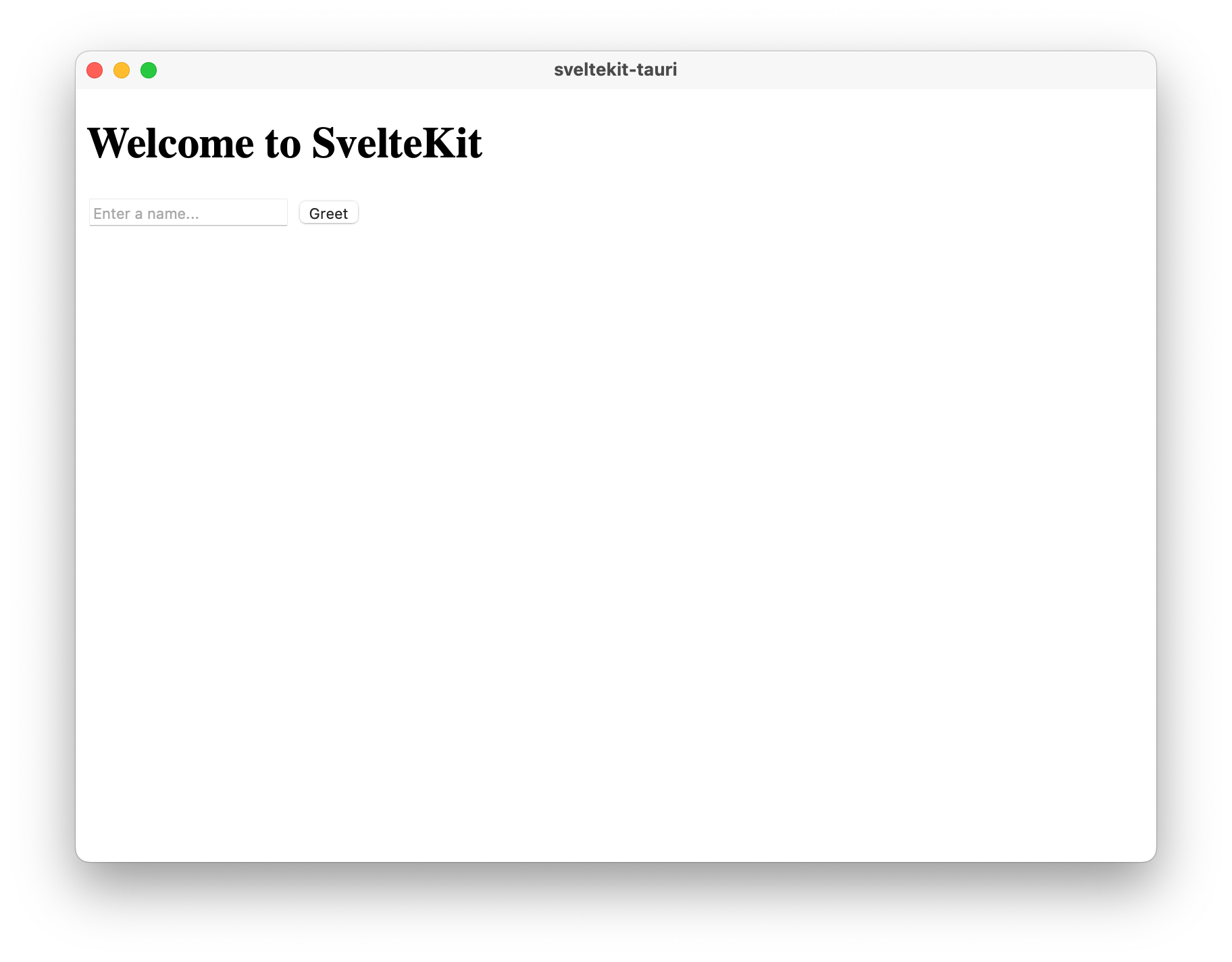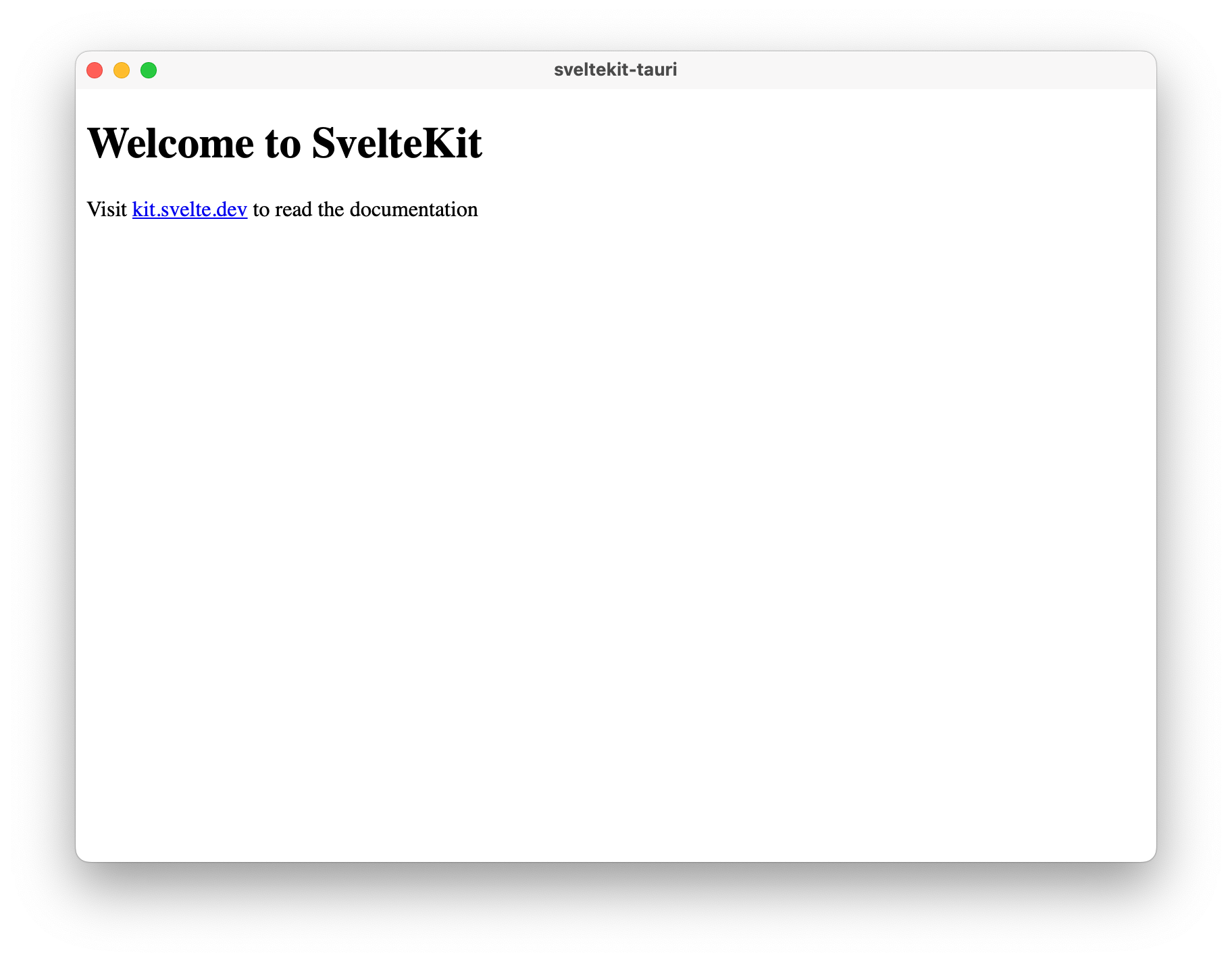SvelteKit
This guide will walk you through creating your first Tauri app using the SvelteKit frontend framework.
Before we continue, make sure you have completed the prerequisites to have a working development environment.
Tauri is a framework to build desktop applications with any frontend framework and a Rust core. Each app consists of two parts:
- Rust binary that creates the windows and exposes native functionality to those windows
- Frontend of your choice that produces the user interface inside the window
In the following, we will first scaffold the frontend, set up the Rust project, and lastly show you how to communicate between the two.
Here's a preview of what we will be building:

Create the Frontend
SvelteKit is a Svelte Frontend that is primarily designed for Server-Side Rendering (SSR). To make SvelteKit work with Tauri we are going to disable SSR and use @sveltejs/adapter-static to create a frontend based on Static-Site Generation (SSG).
SvelteKit comes with a scaffolding utility similar to create-tauri-app that can quickly set up a new project with many customization options. For this guide, we will select the TypeScript template, with ESLint and Prettier enabled.
- npm
- Yarn
- pnpm
- Bun
npm create svelte@latest
yarn create svelte
pnpm create svelte
bunx create-svelte
Project name
This will be the name of your JavaScript project. Corresponds to the name of the folder this utility will create but has otherwise no effect on your app. You can use any name you want here.App template
We will select theSkeleton projectfor a barebones template. If you want to play around with a more complete SvelteKit example you can selectSvelteKit demo app.Type checking
Whether you want type checking via JSDoc or TypeScript in your project. For this guide, we assume you choose TypeScript.Code linting and formatting
Whether you want to start your project with ESLint for code linting and Prettier for code formatting. There won't be other mentions about this in this guide, but we recommend enabling these 2 options.Browser testing
SvelteKit offers built-in Playwright support for browser testing. Since Tauri APIs don't work in Playwright, we recommend not adding it. Check out our WebDriver documentation for alternatives using Selenium or WebdriverIO instead of Playwright.
SvelteKit in SSG mode
First, we need to install @sveltejs/adapter-static:
- npm
- Yarn
- pnpm
- Bun
npm install --save-dev @sveltejs/adapter-static
yarn add -D @sveltejs/adapter-static
pnpm add -D @sveltejs/adapter-static
bun add --dev @sveltejs/adapter-static
Then update the adapter import in the svelte.config.js file:
import adapter from '@sveltejs/adapter-static' // This was changed from adapter-auto
import { vitePreprocess } from '@sveltejs/vite-plugin-svelte'
/** @type {import('@sveltejs/kit').Config} */
const config = {
// Consult https://kit.svelte.dev/docs/integrations#preprocessors
// for more information about preprocessors
preprocess: vitePreprocess(),
kit: {
adapter: adapter(),
},
}
export default config
Lastly, we need to disable SSR and enable prerendering by adding a root +layout.ts file (or +layout.js if you are not using TypeScript) with these contents:
export const prerender = true
export const ssr = false
Note that static-adapter doesn't require you to disable SSR for the whole app but it makes it possible to use APIs that depend on the global window object (like Tauri's API) without Client-side checks.
Furthermore, if you prefer a Single-Page Application (SPA) mode over SSG, you can change the adapter configurations and +layout.ts according to the adapter docs.
Create the Rust Project
At the heart of every Tauri app is a Rust binary that manages windows, the webview, and calls to the operating system through a Rust crate called tauri. This project is managed by Cargo, the official package manager and general-purpose build tool for Rust.
Our Tauri CLI uses Cargo under the hood so you rarely need to interact with it directly. Cargo has many more useful features that are not exposed through our CLI, such as testing, linting, and formatting, so please refer to their official docs for more.
If you haven't installed the Tauri CLI yet you can do so with one of the below commands. Aren't sure which to use? Check out the FAQ entry.
- npm
- Yarn
- pnpm
- Bun
- Cargo
npm install --save-dev @tauri-apps/cli@">1.0.0"
"scripts": {
"tauri": "tauri"
}
yarn add -D @tauri-apps/cli@^1.0.0
pnpm add -D @tauri-apps/cli@1
bun add -D @tauri-apps/cli@1.0.0
cargo install tauri-cli --version "^1.0.0"
To scaffold a minimal Rust project that is pre-configured to use Tauri, open a terminal and run the following command:
- npm
- Yarn
- pnpm
- Bun
- Cargo
npm run tauri init
yarn tauri init
pnpm tauri init
bunx tauri init
cargo tauri init
It will walk you through a series of questions:
- What is your app name?
This will be the name of your final bundle and what the OS will call your app. You can use any name you want here. - What should the window title be?
This will be the title of the default main window. You can use any title you want here. - Where are your web assets (HTML/CSS/JS) located relative to the
<current dir>/src-tauri/tauri.conf.jsonfile that will be created?
This is the path that Tauri will load your frontend assets from when building for production.Use../buildfor this value. - What is the URL of your dev server?
This can be either a URL or a file path that Tauri will load during development.Usehttp://localhost:5173for this value. - What is your frontend dev command?
This is the command used to start your frontend dev server.Usenpm run dev(make sure to adapt this to use the package manager of your choice). - What is your frontend build command?
This is the command to build your frontend files.Usenpm run build(make sure to adapt this to use the package manager of your choice).
If you're familiar with Rust, you will notice that tauri init looks and works a lot like cargo init. You can just use cargo init and add the necessary Tauri dependencies if you prefer a fully manual setup.
The tauri init command generates a folder called src-tauri. It's a convention for Tauri apps to place all core-related files into this folder. Let's quickly run through the contents of this folder:
Cargo.toml
Cargo's manifest file. You can declare Rust crates your app depends on, metadata about your app, and much more. For the full reference see Cargo's Manifest Format.tauri.conf.json
This file lets you configure and customize aspects of your Tauri application from the name of your app to the list of allowed APIs. See Tauri's API Configuration for the full list of supported options and in-depth explanations for each.src/main.rs
This is the entry point to your Rust program and the place where we bootstrap into Tauri. You will find two sections in it:src/main.rs#![cfg_attr(not(debug_assertions), windows_subsystem = "windows")]
fn main() {
tauri::Builder::default()
.run(tauri::generate_context!())
.expect("error while running tauri application");
}The line beginning with the
cfg! macroserves just one purpose: it disables the command prompt window that would normally pop up on Windows if you run a bundled app. If you're on Windows, try to comment it out and see what happens.The
mainfunction is the entry point and the first function that gets invoked when your program runs.icons
Chances are you want a snazzy icon for your app! To get you going quickly, we included a set of default icons. You should switch these out before publishing your application. Learn more about the various icon formats in Tauri's icons feature guide.
Now that we have scaffolded our frontend and initialized the Rust project the created tauri.conf.json file should look like this:
{
"build": {
// This command will execute when you run `tauri build`.
"beforeBuildCommand": "npm run build",
// This command will execute when you run `tauri dev`
"beforeDevCommand": "npm run dev",
"devPath": "http://localhost:5173",
"distDir": "../build"
},
And that's it! Now you can run the following command in your terminal to start a development build of your app:
- npm
- Yarn
- pnpm
- bun
- Cargo
npm run tauri dev
yarn tauri dev
pnpm tauri dev
bunx tauri dev
cargo tauri dev

Invoke Commands
Tauri lets you enhance your frontend with native capabilities. We call these Commands, essentially Rust functions that you can call from your frontend JavaScript. This enables you to handle heavy processing or calls to the OS in much more performant Rust code.
Let's make a simple example:
#[tauri::command]
fn greet(name: &str) -> String {
format!("Hello, {}!", name)
}
A Command is just like any regular Rust function, with the addition of the #[tauri::command] attribute macro that allows your function to communicate with the JavaScript context.
Lastly, we also need to tell Tauri about our newly created command so that it can route calls accordingly. This is done with the combination of the .invoke_handler() function and the generate_handler![] macro you can see below:
fn main() {
tauri::Builder::default()
.invoke_handler(tauri::generate_handler![greet])
.run(tauri::generate_context!())
.expect("error while running tauri application");
}
Now you're ready to call your Command from the frontend!
To call our newly created command we will use the @tauri-apps/api JavaScript library. It provides access to core functionality such as windows, the filesystem, and more through convenient JavaScript abstractions. You can install it using your favorite JavaScript package manager:
- npm
- Yarn
- pnpm
- Bun
npm install @tauri-apps/api@1
yarn add @tauri-apps/api@^1.0.0
pnpm add @tauri-apps/api@1
bun add @tauri-apps/api@1.0.0
With the library installed, we can now create a new Svelte component. We'll create it in src/lib/Greet.svelte:
<script>
import { invoke } from '@tauri-apps/api/tauri'
let name = ''
let greetMsg = ''
async function greet() {
greetMsg = await invoke('greet', { name })
}
</script>
<div>
<input id="greet-input" placeholder="Enter a name..." bind:value="{name}" />
<button on:click="{greet}">Greet</button>
<p>{greetMsg}</p>
</div>
You can now add this component into src/routes/+page.svelte:
<script>
import Greet from '../lib/Greet.svelte'
</script>
<h1>Welcome to SvelteKit</h1>
<Greet />
You can now run this with npm run tauri dev and see the result:

If you want to know more about the communication between Rust and JavaScript, please read the Tauri Inter-Process Communication guide.